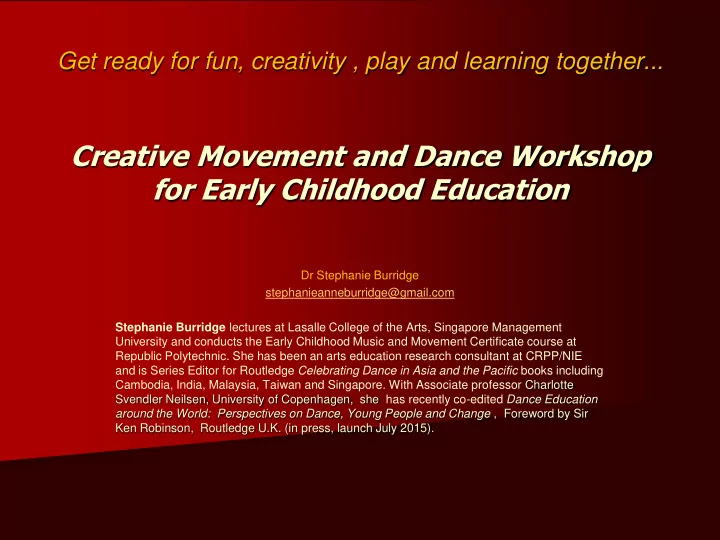

Get ready for fun, creativity , play and learning together... Creative Movement and Dance Workshop for Early Childhood Education Dr Stephanie Burridge stephanieanneburridge@gmail.com Stephanie Burridge lectures at Lasalle College of the Arts, Singapore Management University and conducts the Early Childhood Music and Movement Certificate course at Republic Polytechnic. She has been an arts education research consultant at CRPP/NIE and is Series Editor for Routledge Celebrating Dance in Asia and the Pacific books including Cambodia, India, Malaysia, Taiwan and Singapore. With Associate professor Charlotte Svendler Neilsen, University of Copenhagen, she has recently co-edited Dance Education around the World: Perspectives on Dance, Young People and Change , Foreword by Sir Ken Robinson, Routledge U.K. (in press, launch July 2015).
Did you know that when you dance, your body encapsulates important information on human behaviour in a cultural context? Besides creative, social, and health benefits, dance is an expressive tool for learning. Children can learn about their world through experiencing movement and communicate their thoughts and feelings in non- verbal expression.
Workshop content will include: Some background The Singapore context Philosophy – some key thinkers and Our community, our home, our dance direction Devising cultural dances - history and Creativity – the essence of ECE stories about these. Play – “...the work of the child” Local and global components – home, Learning and creating together family, community, cultural groups, Games and Icebreakers world views and events. Somatic experiences – using tactile The environment – the classroom, imagery – water, sand, crumpled playground, local and global interests. paper Structured creative movement Components of creating, presenting, Laban basics evaluating and reflecting. Multi-modal approaches – reflection and expression through many forms Creative meaning-making Use of stimuli such as music, hand- made instruments, stories, poems, visual imagery. Use of metaphors and imagery for movement classes
Developing movement skills Large-muscle or gross-motor development. This type of development refers to the use of large-muscle groups in the legs (running) or arms (throwing). Small-muscle or fine-motor development This is also is included in the physical development of a child, and deals with such areas as smiling, picking up a fork or tying a shoe. Locomotor Movement Movement of the body from place to place is involved in locomotor movement. Physical abilities such as crawling, walking, hopping, jumping, running, leaping, galloping and skipping are examples of locomotor movement. This type of movement helps develop gross-motor skills. Nonlocomotor Movement Movement of the body while staying in one place is involved in nonlocomotor movement. Physical abilities such as pushing, pulling, twisting, turning, wiggling, sitting and rising are examples of nonlocomotor movement. This type of movement helps develop balance and coordination skills.
Laban Movement Analysis (LMA) is internationally acknowledged as an important building block for dance education MOVEMENT FACTORS – Space, Weight, Time and Flow EFFORT FACTORS – the quality/dynamics of the movement; for instance fast, slow, strong, weak, sudden or sustained. Together these factors form the basis of all movement: • Space: Direct / Indirect • Weight: Strong / Light • Time: Sudden (or Quick) / Sustained • Flow: Bound / Free
Some learning outcomes... Age-appropriate development in dance – gross motor and fine-motor development; loco and non-locomotor movement skills. Development of course curricula or syllabi. Classroom activities. Develop creative ideas for creating dances. Assess children’s learning, embodiment and understanding of key concepts in learning. Connect dance education experiences to other avenues of learning and life.
Recommend
More recommend